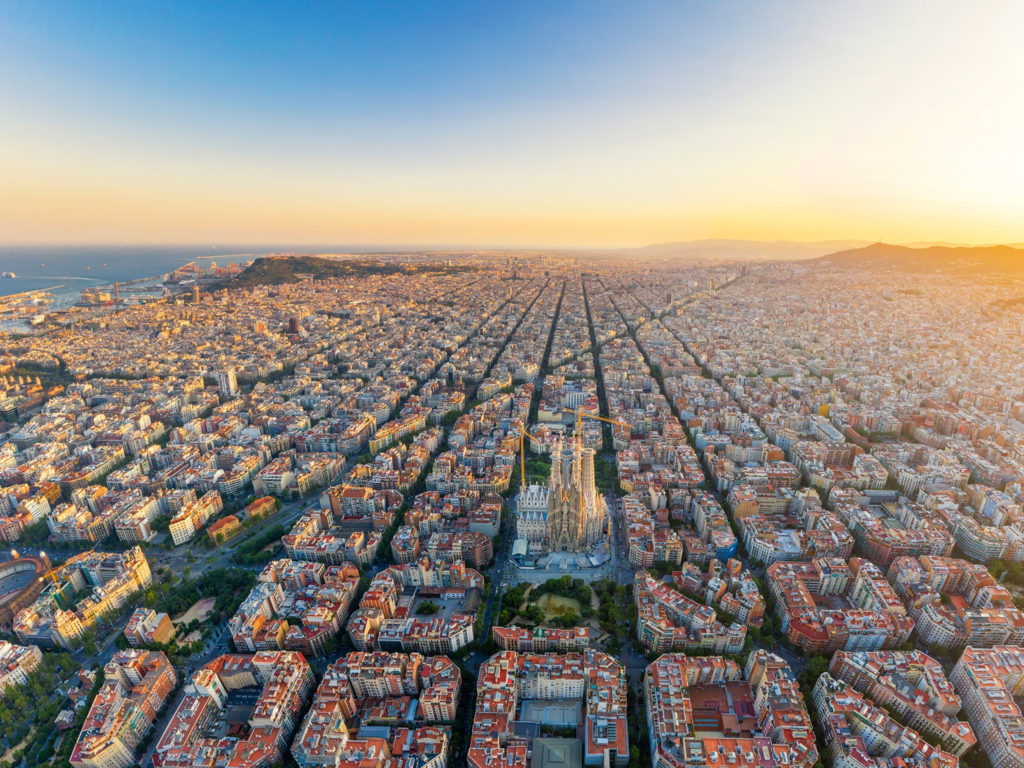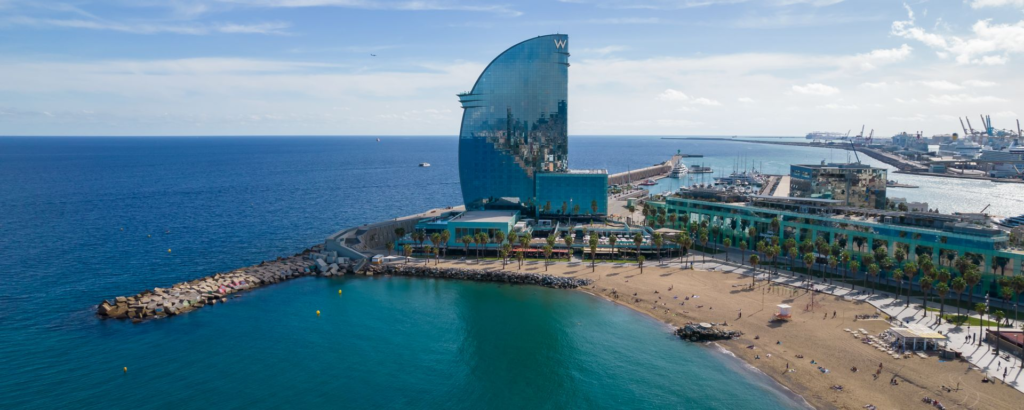Spain, with its rich history, stunning landscapes, and vibrant culture, is a must-visit destination for travelers seeking diverse experiences. Planning a trip to Spain for seven days can be both exciting and overwhelming, given the vast array of attractions the country has to offer. In this detailed guide, we’ll walk through a well-balanced itinerary, covering key cities, must-see sights, travel logistics, and useful tips, all while keeping things simple and affordable.
Day 1: Arrival in Madrid

Morning: After arriving at Madrid Barajas International Airport (MAD), you’ll likely want to check into your hotel and freshen up. Madrid offers a wide range of accommodation options, from budget stays to luxury hotels. Expect to spend around €80–€120 per night for a mid-range hotel. If you’re traveling on a budget, hostels or smaller pensions may cost around €40–€70 per night.
Afternoon: Start your exploration with the grand Puerta del Sol, the symbolic center of Spain. This bustling square is a perfect place to get a sense of the city’s vibe. From here, take a short walk to Plaza Mayor, an iconic spot where you can enjoy some tapas in one of the outdoor cafés. A typical tapas dish costs around €5–€10, depending on what you order.
Evening: End your first day with a visit to El Retiro Park, a serene green space that offers an escape from the city’s hustle and bustle. You can rent a small rowboat for €8 on the park’s central lake, or simply wander its many paths. Have dinner in the nearby Salamanca district, where a good meal at a local restaurant might set you back around €15–€25 per person.
Day 2: Exploring Madrid’s Cultural Riches

Morning: Start your second day in Madrid with a visit to the Royal Palace (Palacio Real), one of the largest royal palaces in Europe. Tickets cost approximately €12, and the palace opens at 10:00 a.m. Spend a couple of hours admiring its lavish interior and exploring the beautiful gardens.
Afternoon: A short walk away is the Prado Museum, Spain’s most renowned art museum, housing masterpieces by Goya, Velázquez, and El Greco. Admission is around €15, but it’s free in the late afternoon (6:00–8:00 p.m. from Monday to Saturday, and 5:00–7:00 p.m. on Sundays).
Evening: Head over to the Gran Vía, Madrid’s shopping street, for a stroll among its grand architecture. You can catch a show in one of the many theaters or enjoy the nightlife in the Malasaña or Chueca neighborhoods. A night out in Madrid can range from €10 for drinks in a bar to €30+ if you decide to visit a trendy nightclub.
Day 3: Toledo – The Ancient Capital

Morning: On day three, take a day trip to Toledo, just 30 minutes away from Madrid by high-speed train (€13–€15 one-way ticket). Toledo is a UNESCO World Heritage Site, known for its medieval charm, impressive cathedral, and mix of Christian, Jewish, and Islamic influences.
Afternoon: Visit the Toledo Cathedral, an architectural masterpiece, where entrance costs around €10. Spend time wandering the narrow streets of the old town, and make sure to stop at the Alcázar of Toledo, an imposing fortress with panoramic views over the city. Entrance costs €5.
Evening: Return to Madrid by train in the evening and have dinner at one of Madrid’s local taverns, where you can enjoy a traditional Spanish dish like paella for around €15–€20.
Day 4: Seville – Andalusia’s Capital

Morning: On day four, hop on a high-speed train from Madrid to Seville. Tickets for the AVE train range from €45–€65, depending on how early you book. The journey takes around 2.5 hours. Once in Seville, check into your hotel. Expect to pay around €70–€120 per night for mid-range accommodation.
Afternoon: Visit the Seville Cathedral, the largest Gothic cathedral in the world, and the Giralda Tower, a symbol of the city. Entrance to the cathedral and tower costs approximately €10–€12. Next, head to the Alcázar of Seville, a royal palace renowned for its stunning Mudejar architecture. Entrance costs around €13.
Evening: Walk along the Guadalquivir River and visit the Plaza de España, one of Spain’s most beautiful squares. You can finish your evening with a traditional Andalusian flamenco show at a local venue, which typically costs around €20–€30 for a ticket.
Day 5: Seville to Granada

Morning: Take an early morning bus or train to Granada, with tickets ranging from €20–€35. Granada is a city famous for its Moorish heritage, stunning palaces, and vibrant student life.
Afternoon: Begin your exploration with a visit to the Alhambra, Spain’s most iconic monument and a UNESCO World Heritage Site. The Alhambra is a breathtaking palace and fortress complex that blends Islamic architecture with Renaissance elements. Tickets need to be booked in advance and cost around €14. Plan to spend a few hours here, as there’s plenty to see, including the Nasrid Palaces and the Generalife Gardens.
Evening: After exploring the Alhambra, take a stroll through the Albaicín, Granada’s old Moorish quarter, where narrow winding streets offer some of the best views of the Alhambra at sunset. Have dinner in one of the local tapas bars; in Granada, tapas are often complimentary with a drink, making it an affordable dining experience.
Day 6: Granada to Barcelona

Morning: On day six, fly from Granada to Barcelona, with prices starting from €40–€60 for budget airlines like Vueling or Ryanair. Once in Barcelona, check into your hotel; expect to spend around €80–€130 for mid-range accommodation.
Afternoon: Start your Barcelona adventure with a visit to La Sagrada Família, the famous unfinished basilica designed by Antoni Gaudí. Entrance costs €26 for a standard ticket. Afterward, take a stroll down Passeig de Gràcia, home to some of Gaudí’s other masterpieces like Casa Batlló and La Pedrera, where tickets range from €20–€25 each.
Evening: In the evening, head to the Gothic Quarter for a more historic vibe. The narrow, winding streets are filled with bars, restaurants, and boutiques. Dinner in Barcelona can range from €15–€30, depending on the type of cuisine you prefer.
Day 7: Discovering Barcelona

Morning: Begin your last day in Spain by visiting Park Güell, another of Gaudí’s iconic creations. The park offers colorful mosaics, whimsical structures, and fantastic views over the city. Entry costs €10. You can spend the morning here soaking up the creative genius of Gaudí and enjoying a leisurely walk.
Afternoon: Head to Barceloneta Beach for some relaxation or a casual walk along the promenade. This area is lined with seafood restaurants where a meal might cost around €20–€30. If you’re more of an art enthusiast, you can substitute the beach with a visit to the Picasso Museum, with an entry fee of around €12.
Evening: Conclude your 7-day trip with a visit to the Magic Fountain of Montjuïc, a popular evening attraction known for its dazzling water and light show. The show is free, and it’s a perfect way to end your Spanish adventure.
Keep reading: Barcelona, Spain : Top attractions and places to visit
Travel Tips and Budget Breakdown
Accommodation: €70–€120 per night (mid-range), €40–€70 (budget)
- Total accommodation cost for 7 nights: €500–€800
Food: €20–€50 per day, depending on where you eat and how much you indulge in tapas or dining at fancier restaurants.
- Total food cost: €150–€350
Transport:
- Train from Madrid to Toledo: €26 round trip
- AVE train from Madrid to Seville: €45–€65
- Bus or train from Seville to Granada: €20–€35
- Flight from Granada to Barcelona: €40–€60
- Total transport cost: €150–€200
Attractions:
- Madrid: €40–€50 (Royal Palace, Prado Museum, Retiro Park)
- Toledo: €15–€20 (Toledo Cathedral, Alcázar)
- Seville: €30–€40 (Cathedral, Giralda Tower, Alcázar)
- Granada: €14 (Alhambra)
- Barcelona: €70–€80 (Sagrada Família, Park Güell, Casa Batlló, La Pedrera)
- Total attractions cost: €170–€200
Total Estimated Cost: €1000–€1500 per person for 7 days, depending on accommodation, dining choices, and extra activities.
Read more: Why Should You Move to Live in Spain?



